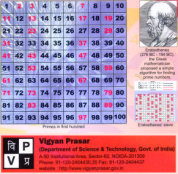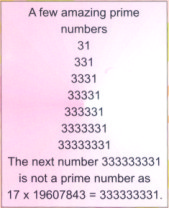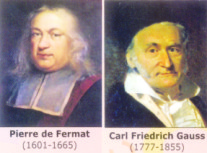
Mathematicians have been asking questions about prime numbers for more than twenty-five centuries, and every answer seems to generate a flurry of new questions. Throughout the history of prime numbers all gifted mathematicians—Pythagoras, Euclid to Fermat, Gauss, and twentieth century mathematicians including Ramanujan figure prominently. Most of the unsolved equations in mathematics are related to prime numbers.
 A prime number (or a prime) is an integer greater than 1 that can be divided only by itself and 1. A natural number greater than 1 that is not a prime number is called a composite number. For example 5 is prime, as it is divisible by only 1 and 5, whereas 6 is composite, because it has the divisors 2 and 3 in addition to 1 and 6.
A prime number (or a prime) is an integer greater than 1 that can be divided only by itself and 1. A natural number greater than 1 that is not a prime number is called a composite number. For example 5 is prime, as it is divisible by only 1 and 5, whereas 6 is composite, because it has the divisors 2 and 3 in addition to 1 and 6.
There are an infinite number of prime numbers. Another way of saying this is that the sequence 2, 3, 5, 7, 11, 13, …of prime numbers never ends. 1 is not a prime number.
One of the intriguing aspects of the primes is that there are an infinite number of primes and they seem to be scattered randomly among the integers, with no apparent pattern governing their distribution. The list of primes never ends. In fact, all attempts to find a formula that will produce only primes have so far failed. However, the distribution of primes and the statistical behaviour of primes on the whole, can be modelled.
 The fundamental theorem of arithmetic establishes the central role of prime in number theory: any integer greater than 1 can be expressed as a product of primes that is unique up to ordering. This theorem requires excluding 1 as a prime.
The fundamental theorem of arithmetic establishes the central role of prime in number theory: any integer greater than 1 can be expressed as a product of primes that is unique up to ordering. This theorem requires excluding 1 as a prime.
There are a number of open questions involving prime numbers, like, every even integer greater than 2 can be expressed as the sum of two primes (for example 4= 2+2, 12 = 5+7, 24 = 19+5); there are infinite pairs of primes whose difference is 2 (called twin prime). Such questions spurred the development of various branches of number theory, focusing on analytic or algebraic aspects of numbers.
Primes, once the exclusive domain of pure mathematics, have recently found an unexpected ally in matters of computer security. Based on the difficulty of factoring a product of two very large primes, public-key cryptography was invented.
Since 1951 all the largest known primes have been found by computers. The search for ever larger primes has generated interest outside mathematical circles. The Great Internet Mersenne Prime Search and other distributed computing projects to find large prime have become popular in the last ten to fifteen years, while mathematicians continue to struggle with the theory of primes.














Comments